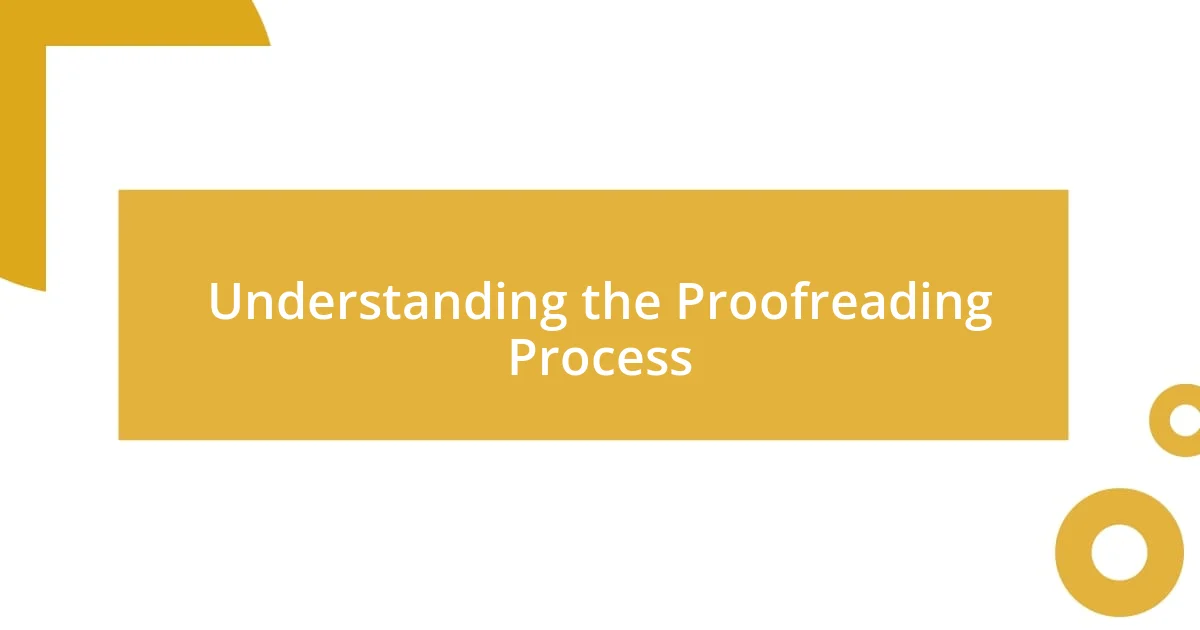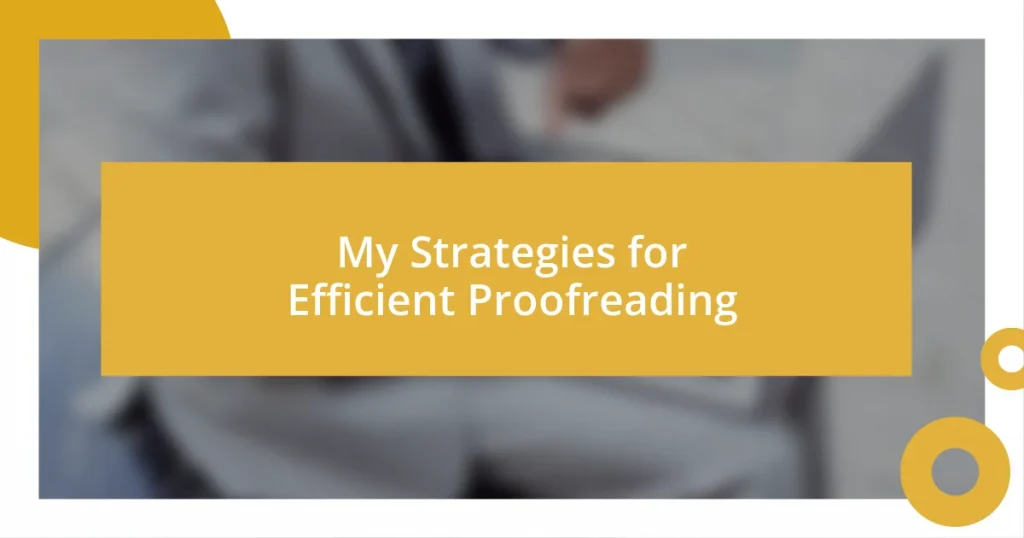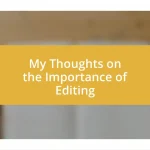Key takeaways:
- Effective proofreading involves not just correcting errors but also enhancing clarity and coherence; reading aloud and taking breaks can significantly improve the process.
- Common challenges such as fatigue, word blindness, and emotional attachment can hinder proofreading quality; recognizing these helps in preparation and approach.
- Utilizing technology, setting up a structured checklist, and having a final review phase contribute to a more effective proofreading strategy and better document quality.

Understanding the Proofreading Process
Understanding the proofreading process is all about recognizing its essential role in crafting polished writing. I remember sitting down with a piece I had written, feeling proud of my words, only to catch glaring typos that threatened to undermine my message. It can be disheartening to realize that what you thought was perfect isn’t quite so; have you ever felt that sudden rush of urgency to fix those mistakes before anyone else sees them?
As I delve deeper into this process, I find that it’s not just about fixing errors but also about enhancing clarity and coherence. When I proofread, I often ask myself, “Does this sentence flow? Will my reader understand my intent?” This mindset shifts the task from mere correction to a more thoughtful engagement with the text. Sometimes, I even read my work aloud to catch awkward phrases—it’s a simple trick that has saved me from many embarrassing blunders.
Moreover, understanding the proofreading process requires patience and a bit of distance from your own writing. I’ve learned that stepping away for a short while can provide fresh eyes when I return. It’s as if my brain hits a refresh button, allowing me to notice issues I once overlooked. Have you tried this before? It can be a game-changer, transforming your proofreading from a chore into an opportunity for growth and refinement.

Common Proofreading Challenges
When I think about common proofreading challenges, it’s hard not to feel an immediate wave of empathy for anyone who has faced them. I recall a time when I reviewed an important document only to discover that I consistently overlooked homophones—words that sound the same but have different meanings, like “there” and “their.” The frustration of missing such simple mistakes can feel like being one step away from clarity but never quite reaching it.
Some of the most frequent challenges I encounter include:
- Fatigue: After spending hours on a piece, maintaining focus becomes increasingly difficult.
- Word Blindness: Familiarity with the text can lead to an inability to see errors, creating a false sense of security.
- Misplaced Confidence: I often think, “I’ve read this a million times; it’s perfect!” only to discover I missed glaring issues.
- Contextual Misunderstandings: Jargon or complex terms can trip me up, especially if I lose sight of the intended audience.
- Emotional Attachment: It’s hard to be objective when I’ve poured my heart into my writing, which can obscure the necessary critical distance needed for effective proofreading.
Recognizing these hurdles not only helps me prepare better but also fosters a sense of camaraderie; we all face similar struggles, and sharing them might just lighten the load.

Setting Up a Proofreading Checklist
When it comes to setting up a proofreading checklist, I find it invaluable to start with a clear structure to avoid missing key details. I like to categorize the checklist into sections—spelling, grammar, punctuation, and formatting. This method not only keeps me organized but also ensures that I don’t overlook specific areas that need my attention.
Additionally, I incorporate personal checkpoints into my checklist. For example, I always ask myself, “Have I read this out loud?” or “Could someone unfamiliar with the content understand this?” These self-questioning techniques help create a deeper connection with the text, enabling me to spot errors and inconsistencies that I might otherwise miss. It’s amazing how simple questions can enhance my proofreading process.
Here’s a comparison table highlighting the key components of an effective proofreading checklist that I’ve found helpful:
| Checklist Component | Description |
|---|---|
| Spelling | Check for typos and correct word usage |
| Grammar | Review sentence structure and syntax for clarity |
| Punctuation | Ensure correct usage of commas, periods, and other marks |
| Formatting | Verify consistency in font, size, and spacing |
| Read Aloud | Listen for flow and awkward phrasing |
| Peer Review | Involve another set of eyes for fresh perspective |

Utilizing Technology for Proofreading
When it comes to utilizing technology for proofreading, I can’t stress enough how transformative tools can be. I’ve relied on grammar-checking software like Grammarly as my trusty sidekick; it catches errors that my tired eyes often miss late at night. Have you ever wondered how such tools manage to spot mistakes so effectively? They analyze context and learn from millions of texts, providing suggestions that enhance not just correctness but also style.
I remember once using an AI-based tool while editing an important presentation for work. It flagged some awkward phrasing that I had overlooked, suggesting more concise alternatives. The relief I felt when I implemented those changes was palpable—it felt like a weight lifted off my shoulders! Technology isn’t just about efficiency; it can serve as a mentor, guiding us toward clearer communication.
Another favorite of mine is how easily I can use text-to-speech features on my devices. Listening to my writing as it is read aloud reveals errors I might not catch while reading silently. It’s like having a supportive friend gently nudging me to notice that misplaced comma or that repetitive word usage. What about you? Have you tried integrating such technology into your proofreading process? Trust me; I find that my relationship with technology in proofreading grows stronger with each project, making me a better writer along the way.

Strategies for Focused Proofreading
Focusing during proofreading can sometimes feel like a daunting task, but I’ve found that creating a distraction-free environment significantly enhances my concentration. When I proofread, I turn off notifications on my phone and close unnecessary tabs on my computer. This simple act of removing distractions allows me to immerse myself fully in the text, making it easier to catch those sneaky errors that could easily slip past me.
Another strategy I employ is taking breaks between proofreading sessions. It’s tempting to try and plow through an entire document in one go, but I’ve learned the hard way that fatigue dulls my attention. After overcoming the temptation of relentless reading, I take short breaks to refresh my mind. I’ve noticed that returning to my work with fresh eyes often reveals mistakes I didn’t perceive before. How about you? Have you ever tried stepping away from your work only to return with a renewed perspective?
Lastly, I swear by working on printed copies rather than just digital files. There’s something about the tactile experience of holding paper that shifts my focus. I often find that physically crossing out errors and making notes in the margins makes the proofreading process feel more engaging. Plus, the act of marking up a printed document gives me a sense of accomplishment. Isn’t it interesting how changing your medium can impact your attention and effectiveness?

Effective Time Management Techniques
When it comes to effective time management, I’ve discovered that setting specific deadlines for each proofreading session really enhances my productivity. I often assign myself a time limit for reviewing a certain number of pages or sections. It’s surprising how the pressure of a ticking clock can sharpen my focus; I find myself working more efficiently and staying engaged with the text. Have you noticed that deadlines can be a bit of a double-edged sword? They can provoke anxiety, but when approached strategically, they foster a sense of urgency that often leads to better results.
I also believe in the importance of prioritizing tasks based on the complexity of the material. For instance, when I’m proofreading long, intricate documents, I tend to tackle them earlier in the day when my mind is fresh. This approach allows me to allocate my mental energy in a way that feels balanced and effective, minimizing the weariness I can feel later on. Think about your own energy levels throughout the day—do you find that certain tasks drain you more than others? Adjusting my proofreading schedule according to my most alert hours has made a remarkable difference in how thorough and accurate my work becomes.
Additionally, I use a simple yet powerful tool: a proofreading checklist. This checklist helps me streamline the process by reminding me of common mistakes I tend to overlook, such as subject-verb agreement or punctuation errors. I’ve invested time in crafting a personalized checklist that reflects my specific weaknesses. Have you ever thought about how a personalized approach might save you time in the long run? I find that checking off items as I go gives me a sense of accomplishment and keeps my proofreading sessions organized, making the entire experience much more manageable.

Reviewing and Finalizing Documents
After I’ve completed the initial proofreading, I enter what I call the “final review phase.” This is where I step back and evaluate the document as a whole. I often find myself asking questions like, “Does the argument flow well?” or “Have I maintained a consistent tone throughout?” Looking at the big picture helps me ensure that the document is cohesive and that my proofreading efforts have paid off.
I also love to read the document aloud during this final stage. It’s something I picked up from a mentor early in my career, and it makes such a difference! Hearing the text helps me catch awkward phrasing and missing words that I might miss when reading silently. Believe me, it can be a bit strange at first—standing there talking to yourself—but it really does enhance my connection with the content. Have you ever tried it? You might be surprised at what pops out!
Lastly, before hitting that final “send” button, I take a moment to reflect on my proofreading journey. Did I stick to my strategies? How did I feel during the process? This reflective moment allows me to celebrate not just the challenges overcome but also the improvements made for next time. It’s a great way to end the proofreading journey on a positive note, and honestly, who doesn’t love a little self-acknowledgment after a job well done?















